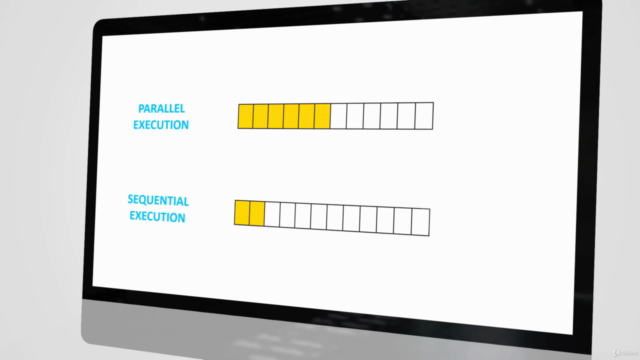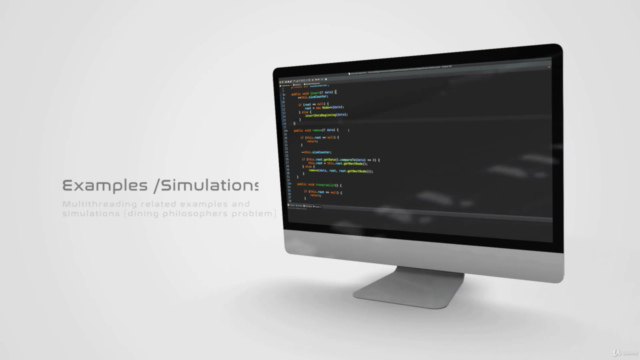Concurrency, Multithreading and Parallel Computing in Java

Why take this course?
🌟 Unlock the Power of Concurrency & Multithreading in Java! 🌟
Course Title: Mastering Concurrency, Multithreading, and Parallel Computing in Java
Course Headline: Dive into Java's Multithreading, Concurrency, MapReduce, Fork-Join Framework, and Stream API with Virtual Threads!
Welcome to the exciting world of asynchronous programming! In this comprehensive course, we will demystify the concepts behind multithreading, concurrency, and parallel computing in Java. These topics are crucial for tackling the challenges presented by Big Data, Machine Learning, and complex computational tasks.
Course Structure:
Section 1 - Multithreading Theory:
- Introduction to Multithreading: Understand the fundamental concepts and how they can enhance performance in Java applications.
- Pros and Cons of Multithreading: Learn about the benefits and potential pitfalls when implementing multithreaded solutions.
- Thread Lifecycle: Get an in-depth look at the life cycle stages a thread goes through from creation to termination.
Section 2 - Threads Manipulation:
- Creating Threads: Discover how to initiate threads using both the
Runnableinterface and theThreadclass. - Threading Communications: Utilize the
join()keyword to ensure threads complete before moving on. - Daemon Threads: Learn how these special threads manage background tasks in your Java application.
Section 3 - Inter-Thread Communication:
- Memory Management of Threads: Understand how memory is managed for different threads.
- Synchronization and Locks: Gain expertise in using
synchronizedblocks, locks, wait/notify mechanisms to manage concurrent operations. - Locks, Latches, and Blocking Queues: Master advanced synchronization techniques with examples like the producer-consumer problem and concurrent collections.
Section 4 - Multithreading Concepts:
- Volatile Keywords: Learn how volatile can be used to guarantee visibility of variable changes across threads.
- Deadlocks and Livelocks: Understand what causes deadlocks and livelocks, and how to prevent them.
- Semaphores, Mutexes, and Philosophers' Dilemma: Explore various synchronization tools and solve classic problems like the dining philosophers.
Section 5 - Executors and ExecutorServices:
- Introduction to Executors: Simplify thread management with Java's Executor framework.
- ExecutorService: Dive into the advanced capabilities of the
ExecutorServiceclass for managing a pool of threads.
Section 6 - Concurrent Collections:
- Synchronization with Collections: Learn how to safely use collections in a multithreaded environment.
- Latches and Cyclic Barriers: Understand these synchronization tools that are critical when you need to coordinate between multiple threads.
- Delay Queues, Priority Queues, and Concurrent Maps: Explore the concurrent collection classes for efficient queue and map operations.
Section 7 - Simulations:
- Dining Philosophers and Library Problems: Implement simulations that demonstrate multithreaded concepts in real-world scenarios.
Section 8 - Parallel Algorithms:
- Understanding Parallel Computing: Learn what parallel computing is and how it differs from multithreading.
- Parallel Merge Sort: Implement a classic sorting algorithm in parallel to understand the differences between sequential and parallel execution.
- Parallel Algorithms in Java: Explore how to apply parallel algorithms to solve complex problems more efficiently.
Section 9 - Fork-Join Framework:
- Introduction to Fork-Join: Understand this concurrency model designed for massive parallelism tasks.
- Structured TaskScope and Subtask: Learn how to structure your tasks effectively within the Fork-Join framework.
Section 10 - Virtual Threads:
- Virtual Threads vs Platform Threads: Explore how virtual threads can be used to improve application scalability.
- Creating and Operating Virtual Threads: Master the creation of virtual threads and their operations using
StructuredTaskScopeandSubtask.
Section 11 - Big Data and MapReduce:
- Introduction to MapReduce: Learn about this programming model designed for processing large data sets across clusters.
- MapReduce with Fork-Join Framework: Understand how the Fork-Join framework can be used to implement MapReduce tasks in Java.
Conclusion:
Thanks for choosing this course to expand your knowledge and skills in concurrency, multithreading, and parallel computing in Java! By the end of this course, you'll be equipped with the tools and techniques necessary to tackle complex computational problems with confidence. Let's embark on this journey together and transform the way you think about asynchronous programming! 🚀
Join us now and start mastering Java's powerful concurrency features today! 🖥️✨
Course Gallery




Loading charts...
Comidoc Review
Our Verdict
This Java-focused concurrency and multithreading course has garnered significant praise from learners. While it covers the subject matter thoroughly with real-life applicable concepts, there are minor issues like inconsistent slide content and suboptimal speech delivery. However, its strong suit lies in practical examples and depth of information. Overall, its solid 4.62 rating reflects its value for developers seeking a deeper understanding of concurrency in Java applications. Despite the room for improvement, this course stands out among Udemy's parallel computing offerings.
What We Liked
- In-depth coverage of concurrency, multithreading, and parallel computation concepts in Java
- Provides practical examples and mini implementations on locks and threads
- Covers a variety of topics including Fork-Join Framework, Stream API, and Virtual Threads
- Real-life applicable knowledge that helps students understand interview questions
Potential Drawbacks
- Occasional issues with font size making it hard to follow along and code
- Slides not consistently matching video contents causing confusion
- Certain examples not available in course materials, requiring extra effort
- Instructor's speech occasionally too fast or broken, impacting focus